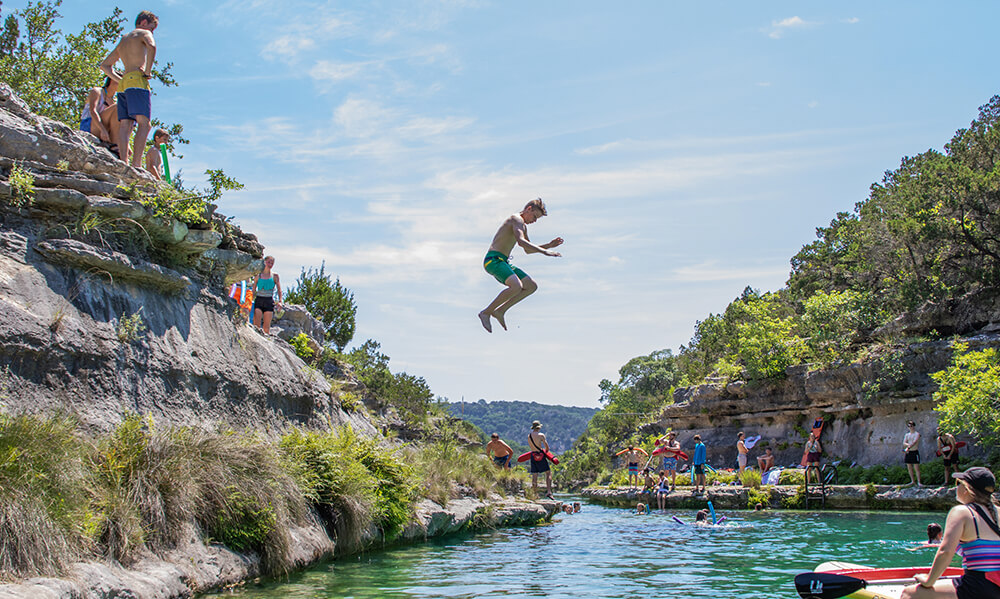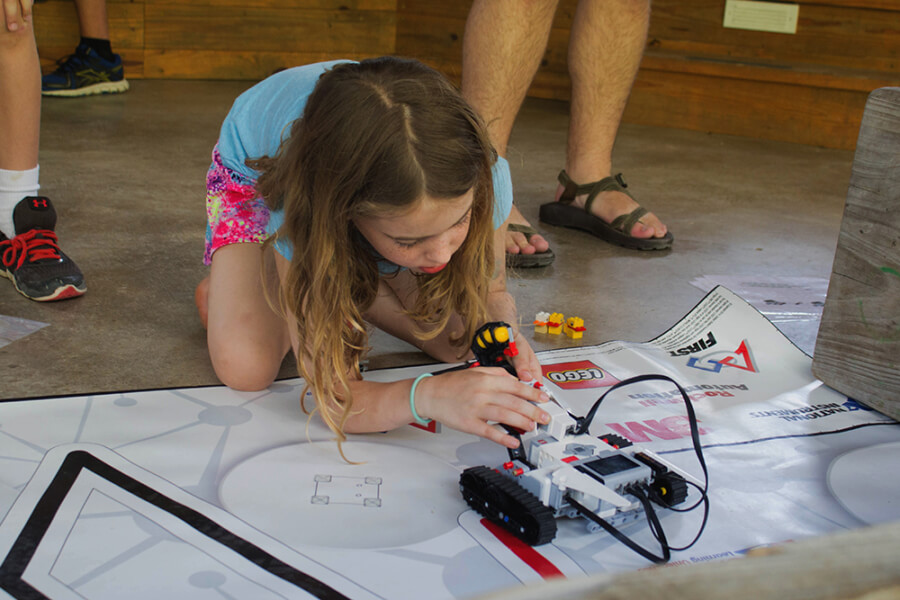
Tom Bowyer remembers one of the moments that led to LLYC’s Rule of no screens at camp.
It was the night of a girl-guy split, and the guys were gathered at Echo Valley’s Pebble Beach for a chili cook-off. Speakers were blasting Texas country from the banks of the Frio, and campers were wrestling and dunking each other. Everything seemed perfectly LLYC until Tom, Echo Valley’s director, looked up from a pot of chili to see four guys looking down at their phones, their faces illuminated in the bluish glow of screenlight.
“What in the world are they doing?” he thought. The Canyon has long been a place where guests can’t stream content—mobile reception isn’t available and Wi-Fi is locked down.
But many campers had planned ahead. They had two weeks’ worth of downloaded content. They plugged in earbuds to hear their music. They played mobile games. Some of them had full movies to watch in their bunks. Several were hiking with their phones in case they reached a ridge with enough service to check in with family and friends.
The moment brought the LLYC directors back to the same question they’d all been asking themselves. What is the role of technology in the Canyon, if any?
That question led to LLYC’s updated screen policy, instituted in summer 2018.
“There is something really special about the people right in front of you being your only option for connection or entertainment,” Tom says.
Parents, campers, and counselors agree. Prior to the policy, many campers and parents complained in surveys about the “always on” problem of people carrying their phones, capturing photos everywhere, and generally failing to unplug.
Since the policy change, campers have grown used to the idea of “no phones,” and parents are thrilled. This year, one parent reported that their camper “comes home on fire every time and does not miss her phone when she is away.” Who needs a phone for the best two weeks?
A no screen policy works for students, but Laity Lodge and Laity Lodge Family Camp are hosting adults who may not have the luxury of unplugging completely from the demands of life.
“We don’t judge guests who need to use their phones or laptops,” says Grant Shellhouse, hospitality manager for Laity Lodge. “No one gets a red W on their chest for using Wi-Fi” during a retreat.
From a hospitality perspective, though, Grant knows some ways of engaging technology can distract people from the retreat experience.
So the Lodge creates what he calls “a gentle barrier,” one-hour vouchers that help guests be a little more intentional before they connect to the internet. “You walk to Reception. You talk to a person,” he explains. “You can’t just take out your phone and accidentally get lost on it.”
This walking and engaging with a person, this act of seeking permission to access the outside world, reminds us that the Canyon is an opportunity to break for a time from the amplified busyness of daily life.
The technology philosopher Albert Borgmann might call this a “focal practice.” In 2011, Laity Lodge held a retreat led by Borgmann, and he introduced the concept of focal practices—any intentional behavior that keeps us directly connected to each other and to the world as humans.
A well-made family dinner—prepared from scratch in the kitchen and enjoyed around a common table—can be a focal practice because it connects people together over food. Similarly, hiking may not be the fastest way to get to Blue Hole, but a hike can be a focal practice that reminds campers and staff how fast humans move across the world when we aren’t driving camp trucks and Suburbans.
Being in the Canyon is itself a kind of focal practice. Whether guests are attending Lodge retreats or Foundation Camp, they are leaving behind all sorts of tech—phones, laptops, tablets, and sometimes even watches. Driving into the river even changes the relationship with our cars and begins the process of letting technology go for a time and being more vulnerable to the world and each other.
Sometimes, technology in the Canyon helps guests think about how they use technology outside of the Canyon.
When Laity Lodge Family Camp added LEGO robotics as an activity, Senior Director Cary Hendricks was very aware that the use of technology needed to be rooted in the Canyon as much as possible. This means the activity takes place in the Roundup pavilion where guests build LEGO robots, program them using iPads and laptops, and drive them on a 4×8 foot map of the Frio Canyon within clear view of Circle Bluff.
It also means the robot obstacles are wooden benches flipped upside down and the robot game addresses Canyon-specific challenges like wild hogs, invasive plants, and target sports. And yes! you can even pretend to drive robots in the river on a large canvas map of the Canyon.
The activity is fun, and it provides a chance to talk with families about how we engage technology.
“For some campers, technology is their thing,” says Hendricks. “This activity uses technology to bring people together in the Canyon in a fun way that isn’t distracting.”
During the activity, counselors invite campers to use the robot arm like a hammer to pound on someone’s foot. It’s harmless, of course, because the robot is made from LEGOs, but it reminds everyone that our toys and our tools can be dangerous. Our actions matter.

Technology makes us stronger when we use cars to go faster than we might otherwise. Technology makes us smarter when we use Google to access vast troves of human knowledge at any time. In Luke 10, Jesus calls us to love God with all of our heart, mind, soul, and strength.
Can we love God with our technologies, too?
When God tells Adam to “cultivate” the garden of Eden, the Hebrew word assumes the use of tools. What is technology if not an increasingly complex set of tools? So, Adam may have used a shovel, a simple tool, a basic technology, and it would have been good.
There are thousands of years between a stone age shovel and a smartphone. But technology is an idea that encompasses both the shovel and the phone, combining two Greek words—tekhnē, which means “art” or “craft,” with logia, “the study of.”
As the son of a carpenter, Jesus was a tekton, or skilled worker. You could say Jesus was a first century technologist.
We don’t consider certain things to be technology at all. (Alan Kay, the Atari and Apple pioneer, has said technology is “any thing that was invented after you were born.”) Trucks always had a presence in the Canyon. The buildings always had electricity and running water. Climbing gear is a kind of technology. Music can add excitement and energy during Roundup or Cody Center concerts, and maybe the music even highlights the stillness when instruments and mics fall silent.
Screens at the Great Hall or in a Roundup pavilion can focus and unify the group to watch a “Did You Know?” video or read Scripture together or sing together.
Yet it remains true that some uses of technology tend to isolate guests from each other and their environment or, at best, separate them into isolated groups. So part of the job of being a camp or retreat director will be to make wise decisions about technology—where it is off limits, where it is good, where it adds, where it detracts.
“Outside of LLYC,” Tom says, “there’s nothing wrong with linking up your phones and playing games sometimes. But you can do that anywhere.”
What you can’t do anywhere is put down your phone and jump in the river at Pebble Beach.